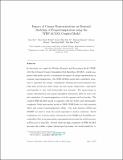Impact of Canopy Representations on Regional Modeling of Evapotranspiration using the WRF-ACASA Coupled Model
Author(s)
Monier, Liyi Xu; Pyles, Rex David; Paw U, Kyaw Tha; Snyder, Richard; Monier, Erwan; Falk, Matthias; Chen, Shu-Hua; ... Show more Show less
DownloadMain article (12.09Mb)
Open Access Policy
Open Access Policy
Creative Commons Attribution-Noncommercial-Share Alike
Alternative title
Impact of canopy representations on regional modeling of evapotranspiration using the WRF-ACASA coupled model
Terms of use
Metadata
Show full item recordAbstract
In this study, we couple the Weather Research and Forecasting Model (WRF) with the Advanced Canopy-Atmosphere-Soil Algorithm (ACASA), a high complexity land surface model, to investigate the impact of canopy representation on regional evapotranspiration. The WRF-ACASA model uses a multilayer structure to represent the canopy, consequently allowing microenvironmental variables such as leaf area index (LAI), air and canopy temperature, wind speed and humidity to vary both horizontally and vertically. The improvement in canopy representation and canopy-atmosphere interaction allow for more realistic simulation of evapotranspiration on both regional and local scales. The coupled WRF-ACASA model is compared with the widely used intermediate complexity Noah land surface model in WRF (WRF-Noah) for both potential (ETo) and actual evapotranspiration (ETa). Two LAI datasets (USGS and MODIS) are used to study the model responses to surface conditions. Model evaluations over a diverse surface stations from the CIMIS and AmeriFlux networks show that an increase surface representations increase the model accuracy in ETa more so than ETo. Overall, while the high complexity of WRF-ACASA increases the realism of plant physiological processes, the model sensitivity to surface representation in input data such as LAI also increases. Keywords: Land surface modeling; WRF; Canopy representation; Regional modeling; Reference evapotranspiration; Actual evapotranspiration
Date issued
2017-08Department
Massachusetts Institute of Technology. Joint Program on the Science & Policy of Global ChangeJournal
Agricultural and Forest Meteorology
Publisher
Elsevier BV
Citation
Xu, Liyi et al. "Impact of canopy representations on regional modeling of evapotranspiration using the WRF-ACASA coupled model." Agricultural and Forest Meteorology, 247 (December 2017): 79-92.
Version: Original manuscript
ISSN
0168-1923